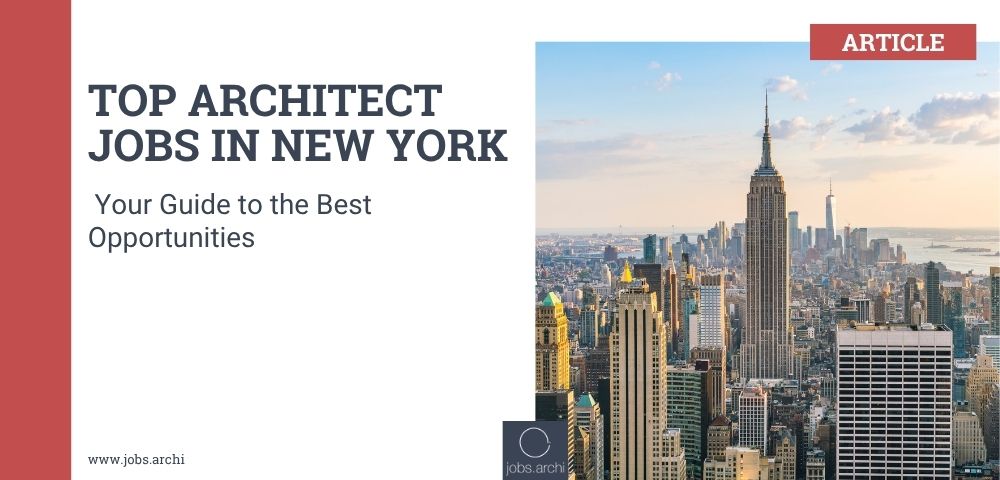Want to find architect jobs in New York? This guide offers essential tips to navigate the market, build a standout resume, and meet licensure requirements. Perfect for both local and international candidates.
Introduction to Architect Careers in New York
New York stands as a global epicenter for architecture, offering a dynamic environment where architects can thrive and innovate. The city’s architecture industry is renowned for its diversity, with opportunities ranging from large, internationally recognized firms to boutique studios with a specialized focus. Whether you’re interested in becoming a project architect, joining leading interior design firms, or working in landscape architecture, New York provides a wealth of career paths. Architects here are involved in a wide array of projects, from designing iconic buildings and revitalizing historic neighborhoods to shaping the city’s infrastructure and public spaces. The constant evolution of New York’s skyline means architects are always at the forefront of new design, construction, and engineering challenges, making it an exciting place to build a meaningful career and leave a lasting mark on the city’s landscape.
Navigating the New York Architectural Job Market

New York’s architectural job market is as diverse as its skyline. Architects in New York work across various sectors, including:
- Residential projects
- Commercial projects
- Public infrastructure projects
- Schools
- Churches
Whether you’re designing a high-rise condominium, a cutting-edge office building, or a public park, the opportunities are vast and varied.
The architectural scene in New York NY is known for its dense urban fabric, historic preservation, and cutting-edge construction design practices. Restoring historic facades and working on projects involving schools and churches are important aspects of the city’s architectural landscape. The city is a melting pot of architectural styles, from historic brownstones to modern buildings, making it a dynamic and competitive market for architects. Queens stands out as a significant area for architectural projects, reflecting the diversity of neighborhoods and project locations across the city. The allure of working on such high-profile projects attracts talent from all over the world, further intensifying the competition.
This guide aims to serve as a practical resource for architects seeking employment in New York City, whether you’re a domestic candidate or an international professional looking to make your mark in one of the world’s leading architectural hubs.
Preparing Your Portfolio and Resume for New York Jobs
An effective architectural resume should seamlessly blend creativity with technical precision, showcasing both your design sensibility and professional experience in detail. It’s not just about listing your qualifications; it’s about telling a compelling story that resonates with hiring managers in New York. Careful selection of work samples is crucial—choose projects that best represent your skills, creativity, and expertise.
Enhance readability by using consistent formatting and clear headings in your resume. Include quantifiable achievements in your professional summary and work experience sections to highlight your impact on previous projects and the completion of key tasks. A well-structured resume should contain sections like:
- Contact information
- Professional summary
- Experience
- Education
- Skills
- Notable projects
- Notable interiors projects
- Review
To meet U.S. and New York standards for your portfolio and resume, consider the following:
- Emphasize innovation, professional clarity, and compliance with local codes and sustainability trends.
- Take advantage of workshops offered by many architecture programs before career fairs.
- Use these workshops to prepare your resumes and portfolios to meet the expectations of New York’s competitive market.
Effective Job-Search Strategies for Architects

The job outlook for architects is promising, with the following key points:
- An anticipated growth of 8% from 2023 to 2033, which is above the average for all professions.
- Approximately 8,500 job openings for architects are expected annually.
- Job openings are largely due to workforce transitions such as retirements. This vibrant market provides numerous opportunities for aspiring architects, including an increasing number of remote and hybrid work options for architects in New York.
Leveraging LinkedIn effectively is crucial for staying informed about industry trends and engaging with potential employers. Share your work, participate in discussions, and build a strong online presence to enhance your visibility. Community-focused design initiatives can also help build your reputation and expand your network, presenting opportunities that might not be advertised. You may also find chances to join leading architecture firms or design teams through networking and professional connections.
Exploring hidden job markets involves:
- Direct outreach to firms you admire.
- Not relying solely on job postings.
- Reaching out to firms and expressing your interest to open doors to opportunities you might not have found otherwise.
Understanding Licensure Requirements and Visa Pathways
Practicing architecture in the U.S. requires a state-specific license since there is no national architecture license. This requirement applies to both domestic and international applicants. If you’re an international architect already licensed in your home country, you can pursue the International Architect Path to meet U.S. licensure requirements.
To qualify for licensure, candidates must complete a certain number of units of credit based on their education and accumulate a minimum number of years of relevant work experience. If educated abroad without a license, complete an Education Evaluation Services for Architects (EESA) evaluation to assess educational qualifications against U.S. standards. Additionally, all applicants must complete the Architectural Experience Program (AXP) as part of the licensure process in the United States.
Enhancing your resume with certifications such as LEED AP and Project Management Professional can significantly boost your credit credibility. These certifications demonstrate specialized knowledge and a commitment to professional development, making you a more attractive candidate in the competitive New York market.
Job Requirements and Qualifications
To excel as an architect in New York, a strong foundation in education and hands-on experience is essential. Most architects hold a professional degree in architecture and have completed internships or relevant work experience, which is often required for licensure. Verification of your skills and experience is a key step, as many firms and clients in New York expect architects to be licensed and to demonstrate a proven track record in the industry. Leadership and design management abilities are highly valued, especially for those aspiring to roles such as project architect or for those looking to lead interior design firms or architecture studios. Proficiency in industry-standard tools like Revit, combined with a meticulous attention to detail, sets candidates apart. Success in New York’s fast-paced environment also depends on the ability to work collaboratively within a team, communicate effectively with clients, and balance the artistic and human aspects of design to create spaces that are both functional and inspiring.
Networking and Industry Events
Networking is not just about finding jobs; it’s about exchanging ideas and staying informed about industry trends. Attending industry events and conferences can facilitate valuable connection that leads to potential job opportunities. Connecting with local architectural associations can provide essential networking opportunities and access to industry events in New York.
Architecture career fairs offer vital opportunities for students to connect with potential employers and learn about job openings at a firm. If you visit these events, participation can enhance your visibility and increase the likelihood of being referred for job positions.
Local architecture groups frequently organize events that allow members to associate with industry leaders and peers in the area, providing a platform for human collaboration and security mentorship within the leadership team based on a sense of action community.
Adapting to New York’s Work Environment

In New York, the architecture sector is known for its dynamic pace, requiring professionals to be agile and responsive to changes in projects and timelines. Successful architects often leverage technology like Revit to enhance communication and project management, enabling better collaboration despite the city’s fast pace in engineering and time.
Collaboration is crucial in New York’s architectural firms. In-person meetings are often necessary to effectively convey complex designs and ensure project success. Highlighting relevant technical and soft skills is essential, as they complement design abilities and improve focus in collaboration. The design manager plays a key role in this process.
Understanding client expectations in New York involves being responsible and available beyond traditional office hours, accommodating clients’ varied schedules at all times.
Top Architecture Firms to Consider

New York is home to several leading architecture firms that consistently offer employment opportunities for architects. SHoP Architects integrates advanced digital techniques, specializing in both residential and commercial projects. Robert A.M. Stern Architects is renowned for its elegant blend of traditional and modern styles in residential design, including house design.
Ennead Architects is known for its community-oriented design, particularly in educational and civic projects. Selldorf Architects has gained acclaim for its high-end residential and art institution designs, emphasizing timeless aesthetics. Studio Gang prioritizes social equity in architecture, focusing on community impact and environmental design. Consulting For Architects, Inc. is another prominent firm, recognized for its expertise in connecting architects with top opportunities in the industry.
Working for these leading firms can significantly enhance an architect’s career trajectory, offering exposure to prestigious projects and valuable industry connections. Many of these firms foster a collaborative environment, facilitating continuous professional development and networking.
Specializations in Demand
The architectural landscape in New York is seeing a rising demand for various specializations, driven by unique urban needs and innovative trends. Skidmore, Owings & Merrill is recognized for its impactful commercial architecture and urban planning projects, notably reshaping lower Manhattan. BIG – Bjarke Ingels Group focuses on sustainability and innovative design, with a reputation for bold urban structures.
Sustainable architecture is increasingly lucrative as demand grows for eco-friendly designs, particularly among professionals with green certifications. FXCollaborative specializes in sustainable architecture, with numerous projects aiming for LEED certification. Diller Scofidio + Renfro is celebrated for transforming public spaces, highlighted by their work on the High Line park.
Healthcare architecture requires specialized knowledge of patient care and strict compliance with regulations, making it one of the highest-earning fields. Industrial architecture, including the design of factories and data centers, offers significant salaries due to the scale and complexity of projects.
Salary and Benefits for Architects in New York
Architects in New York enjoy competitive salaries that reflect the city’s status as a leading hub for design and construction. The salary range varies based on experience, position, and the type of firm—principal architects at large firms often command higher compensation than associates or those working in smaller, residential practices. In addition to base salary, many firms offer comprehensive benefits packages, including health insurance, retirement plans, and opportunities for career advancement. Perks such as paid time off, professional development programs, and 401k plans with employer match are common, helping architects balance work and personal life while planning for the future. While the cost of living in New York is high, the robust salary and benefits packages available to architects make the city an attractive destination for those seeking both professional growth and financial stability.
Architecture Industry Trends in New York
The architecture industry in New York is at the forefront of innovation, with a strong focus on sustainability, technology, and creative design solutions. There is a growing emphasis on green buildings, energy efficiency, and environmentally responsible practices, as firms and clients alike prioritize projects that contribute positively to the city’s future. Human-centered design and the integration of art into architecture are also gaining traction, with architects striving to create spaces that enhance the well-being and experience of users. The adoption of advanced tools like Revit and other BIM technologies is streamlining project management and fostering greater collaboration among team members. As New York continues to expand and evolve, architects are playing a pivotal role in shaping residential, commercial, and infrastructure projects that define the city’s unique character and respond to the needs of its diverse population.
Career Advancement Opportunities
Architects in New York have access to a wide range of career advancement options, thanks to the city’s vibrant and competitive job market. Leadership roles within architecture firms, specialization in areas such as landscape architecture, interior design, or sustainable design, and the opportunity to start your own studio are all viable paths for growth. Many architects choose to expand their expertise into related fields like urban planning or historic preservation, leveraging their education and experience to broaden their impact. Networking through professional organizations, such as the AIA, and engaging in continuing education are essential for staying current with industry trends and best practices. With dedication, skill, and a commitment to ongoing learning, architects in New York can achieve their career goals—whether that means becoming a principal at a leading firm, heading up a design studio, or making a significant contribution to the city’s built environment. The range of options available ensures that ambitious architects can find the right path for their professional journey in New York.
Utilizing Online Job Boards
Many online job boards cater specifically to architects, allowing job seekers to access a range of listings tailored for their field. Utilizing niche job boards can enhance visibility to potential employers looking for specialized skills in architecture. Job postings or firm profiles with higher numbers of views tend to attract more applicants and indicate popular opportunities.
Creating alerts on job boards can help candidates stay informed about new architecture job postings in New York. Some job boards also offer resources like resume tips and interview preparation specifically for the architecture sector.
Enhancing visibility and finding specialized roles through online platforms is essential. Job platforms often provide tools for networking, with features that allow users to connect with companies and other professionals in architecture, proceeding to verify and enhance their career options as required.
Building a Local Network
Networking within New York’s architectural community is vital, as personal connections can lead to new opportunities and resources. Joining local industry organizations, such as AIA New York, provides architects with access to resources, job listings, and networking opportunities.
The Architectural League of New York offers opportunities to engage with a diverse community of professionals and access various educational and networking events. Utilizing LinkedIn effectively can enhance visibility for architects, showcasing their portfolios and engaging with industry networks.
Attending industry meetups and lectures can significantly enhance networking opportunities and foster connections within the architectural community in New York. Joining working groups focused on specific themes can foster deeper connections with other professionals in the architectural field.
Summary
Navigating the architectural job market in New York requires a combination of preparation, networking, and adaptability. Crafting an effective portfolio and resume tailored to New York standards is essential for standing out in the competitive market.
Continuous learning and engagement with the architectural community are crucial for professional growth. Attending industry events, networking, and building a local network can open doors to new opportunities and collaborations.
New York’s architectural scene is dynamic and offers a wealth of opportunities for those willing to put in the effort. By following the strategies outlined in this guide, architects can successfully navigate the New York job market and achieve their career goals.
Frequently Asked Questions
What are the key sectors for architects in New York?
The key sectors for architects in New York include residential, commercial, and public infrastructure projects, reflecting a diverse range of opportunities within the field. These sectors are essential for the development and sustainability of the city’s urban landscape.
How can I tailor my resume and portfolio for New York architectural jobs?
To effectively tailor your resume and portfolio for New York architectural jobs, ensure that your resume balances creativity with technical precision while including quantifiable achievements. Additionally, customize your portfolio to reflect U.S. and New York standards, highlighting innovation and adherence to local codes.
What are some effective job-search strategies for architects in New York?
One effective job-search strategy for architects in New York is to leverage LinkedIn by engaging with industry trends and participating in community-focused design initiatives. Additionally, direct outreach to admired firms can help uncover hidden job opportunities.
What are the licensure requirements for international architects in New York?
International architects seeking licensure in New York must either pursue the International Architect Path or undergo an EESA evaluation, alongside completing the Architectural Experience Program (AXP). It is essential to adhere to these requirements to practice legally in the state.
How important is networking in the New York architectural community?
Networking is essential in the New York architectural community for exchanging ideas, staying updated on industry trends, and uncovering job opportunities. Engaging with local associations and attending events can greatly advance your career.
The post Top Architect Jobs in New York: Your Guide to the Best Opportunities first appeared on jobs.archi.


